A year ago at Oshkosh, I became intrigued by the way Composite FX had developed the older Mosquito into their XE line; multiple models running from a legitimate Part 103 helicopter, their XEL model, to the turbine XET model. The company builds these handsome aircraft in Trenton, Florida after acquiring the design from Canadian John Uptigrove (see image of his original).
 Vertical takeoff has a special appeal, even to those of us with little or no rotary experience. Setting aside the skills to fly such machines, the cost of a helicopter is usually so high that many don’t even consider it. Maybe they didn’t look far enough.
Vertical takeoff has a special appeal, even to those of us with little or no rotary experience. Setting aside the skills to fly such machines, the cost of a helicopter is usually so high that many don’t even consider it. Maybe they didn’t look far enough.
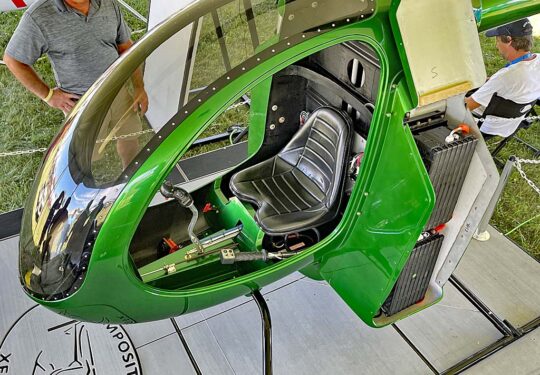 Composite FX and their $60,000 ready-to-fly XEL model (kit for $47,000) completely changes that thought experiment. Not only does this handsome aircraft perform impressively in experienced hands but many can afford it.
Composite FX and their $60,000 ready-to-fly XEL model (kit for $47,000) completely changes that thought experiment. Not only does this handsome aircraft perform impressively in experienced hands but many can afford it.
Yet this article is not about the product line the manufacturer is presently delivering. It’s about a new project a Composite FX electrical engineer put together as a proof-of-concept, using the XE line as his platform. What you see nearby is the first iteration of his work and it has already flown successfully. Curious about run time? So is everyone; I heard the question asked repeatedly. But first…
Putting This In Perspective
The aviation world appears headed to a split of unknowable proportions. We are already into it but it isn’t particularly visible in the “conventional” flying community (that’s us reading this). I rrefer to the chasm between fixed wing aircraft and multicopters.
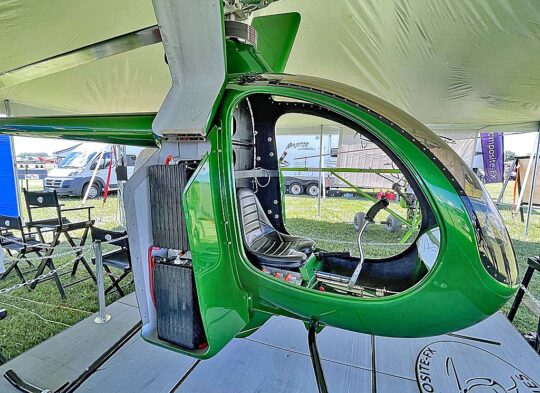
I have no doubt this new direction in airborne technology could lead in fascinating directions, some of which will surely benefit all pilots. However, in any definition of “near-term,” I simply cannot see corporate executives flying from one building in San Francisco to another.
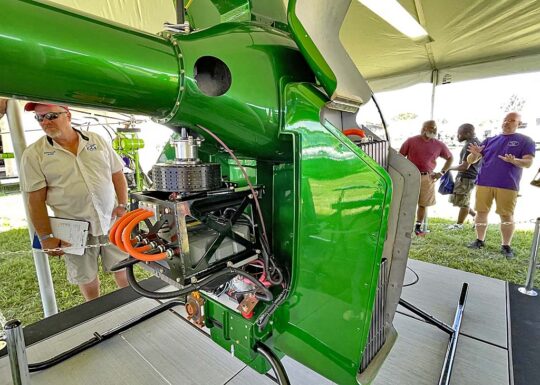
Even if we assume that batteries will make some great leap forward in energy density, convincing a doubtful public that strange contraptions flying over their heads are not a danger will be hard. They will resist the noise a vertical takeoff aircraft makes. Electric motors may be much quieter than an internal combustion engine but the air movement to lift a 4-6 passenger vehicle vertically is going to generate a mighty racket. On a building rooftop in a downtown location, perhaps this is no problem. In your quiet home neighborhood, big problem, at least after the novelty of seeing your first Uber air taxi wears off. Not In My Back Yard (NIMBY) is a ready-made movement to resist this. Let’s get more practical …and near-term.
eXE? the Electric Composite FX
Helicopters run their engines at high revolutions all the time. You adjust flight path and height by modest adjustments, but the powerplant is working at high power most of the time. This can be easily achieved by electric propulsion and with lots less vibration.
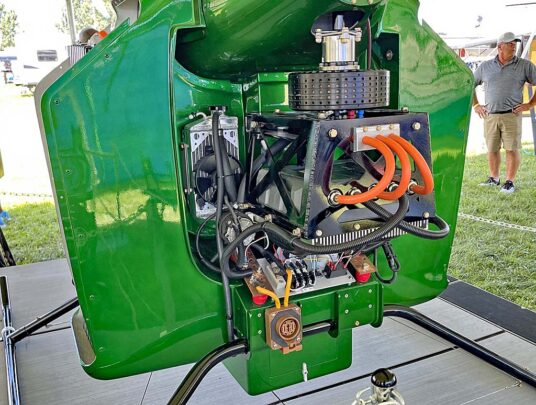
Electric propulsion turns many conventional concepts on their heads. In an ePower system, the motor itself is surprisingly small and compact (nearby image). Obviously more powerful motors will be larger but for a single-place helicopter like the XE series, the motor is flywheel-sized, a stack of old record albums a few inches thick. I marvel at how such a small component can put out such energy.
Electric motors are also good in torque. This suits helicopter operation quite well. Although the energy draw-down on batteries when performing vertical takeoff is rapid, the torque delivers the power that such a takeoff requires.
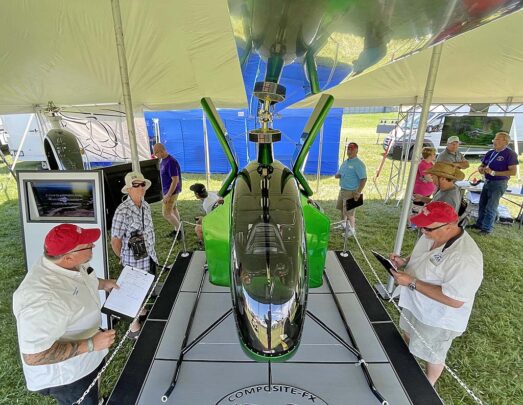
EAA judges in red hats go over eXE very carefully. These fellows miss nothing.
Combustion engines spool up rapidly and in some aircraft that can be very helpful. In a helicopter operating the engine at a near-continuous high rate, spool-up time is not much of a factor. An electric motor is less subject to overheating, although batteries being drawn down quickly can experience higher heat.
Composite FX is studying this project but, as with their other production, even this prototype looks quite impressive. It was good enough that I observed three EAA judges going over the aircraft. They do this with experience and they look very closely. Rough prototypes don’t asked to be judged. Composite FX invited it.
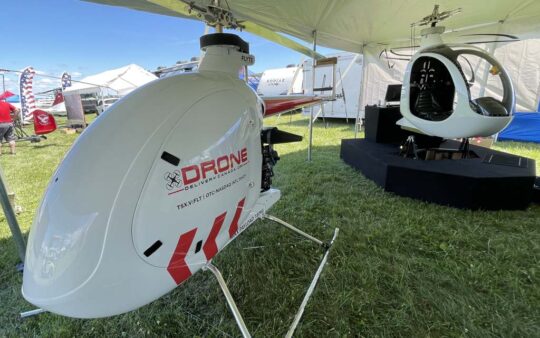
Composite FX buzzes with activity. In addition to manufacturing four models and developing the eXE, they also have a autonomously-flown XE plus a motion simulator (in background).
While the Florida manufacturer can claim very reasonable prices for its regular line, batteries are costly so eXE will not be their most affordable model, I’ll guess. Battery replacement cost is another expense that all electric vehicle owners must confront. You might compare it to TBO-time on an aircraft combustion engine.
Nonetheless, if a 25-minute flight can satisfy your aerial interest, an eXE might be an excellent choice. Other than battery renewal, an electric helicopter should be very low maintenance. That’s something you never hear when discussing helicopter operation.
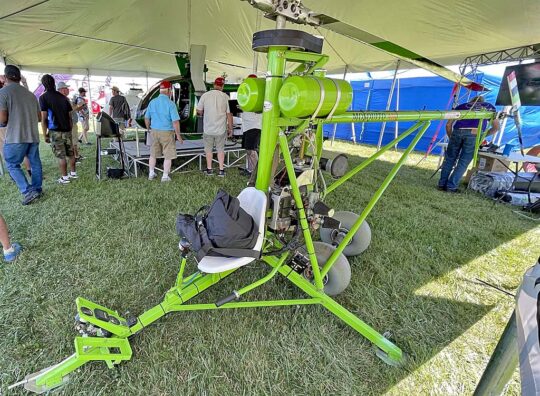
John Uptigrove’s original Mosquito helicopter scene after some refurbishment by Composite FX. The fat tires are used just to roll it around into position.
If Composite FX puts the eXE into production, they could ring the aircraft with a series of floats (as Lift’s Hexa does) and qualify for Part 103, accommodating the 400-pound empty weight with batteries. Wouldn’t that be interesting?
Time to get some shut-eye for Oshkosh – Day 3. Stay tuned! I bet you’ll love tomorrow’s story.
LINKS


News and more info. Thanks.
Very nice, what the max speed?
Actually you should doubt the technology these engineers are creating — from multicopters, to tilt wings, to ducted fans, to hybrid versions of all these. For the most part they are trying to use thrust to lift their aircraft instead of the lift created by a long rotary wing. Their ideas work sub-scale but when they try to lift the weight of a full scale aircraft they can’t do it efficiently.
I never saw a gas or battery [version?] just take off and go up like R22 or R44; they always just hover. Just wondering, are they dangerous or are folks scared of them.
I’m not sure of your point but I’ve witnessed the Mosquito helicopter (now the XE line) fly wonderfully well in skilled hands.
Awesome, hopefully I can convince my wife into getting one.
With the exception of possibly excessive noise and currently-limited duration and range of operation, eVTOLs generate so much interest precisely because they appear poised to provide the holy grail of aerial transportation — point to point in a single simple-to-operate vehicle.
As for Part 103, shouldn’t the empty weight of an electric be compared on an equivalent basis with an ICE model? The latter is measured empty of fuel. Therefore the electric should be weighed without any set of removable batteries. Adding their weight is thus comparable to filling the tank of an ICE. Keeping the comparison of each craft’s limitations should consider just enough battery to contain sufficient energy for the equivalent range and duration provided by a 5-gallon tank on an ICE. If a larger capacity, heavier battery were to be installed, it would be no different than installing an auxiliary removeable gas tank on an ICE. In any case, the legal definitions of the 103 rule would be satisfied. Removable range extenders would merely diminish the carrying capacity, since maximum takeoff weight would remain unchanged.
The idea of batteries on Part 103 ultralight remains somewhat unresolved. When asked about an FAA Legal Department official ruling on batteries that said explicitly that they are not fuel, FAA executives were asked, “If batteries on a Part 103 ultralight are not fuel (and assuming they are not part of structure), what are they?” After a surprisingly long silence, one executive said, “Well, I guess they are luggage.” This has not been more fully defined nor tested in a hearing or inquiry. Such a test could open a huge can of worms — and potentially ruin Part 103 — or it be a salvation; it depends on your perspective.
“Luggage” is an interesting reply. That would mean that removeable batteries are not to be included in the determination of aircraft empty weight. Non-removeable batteries, on the other hand, would have to be included in the empty weight. That carries interesting implications for the design characteristics of Part 103 ultralight electric aircraft. However, since such aircraft cannot fly without that luggage, and even with it only if that luggage is “filled” with energy, then the comparison with ICE ultralights would have to view the batteries as supplemental fuel tanks, whether empty or full. One might similarly consider the empty fuel tank of an ICE as a removeable item not to be counted as part of its empty weight. At least, it could be designed that way.
The real problem is, nonetheless, the faulty focus on aircraft weight rather than performance. Why, after all, are ultralights deemed exempt from the constraints developed to regulate the construction of larger, more capable aircraft? What risks are they intended to mitigate? Now, even performance cannot define ultralight boundaries, because of examples like the jet-propelled flying suit. It’s light, it’s fast, it isn’t limited to low altitudes, but its duration of flight is very limited. Another ultralight consideration that does correspond with weight is its mass and the potential damage of a collision with objects in the air or on the ground. Limiting the mass then must also limit the velocity and thus the total energy of a collision. On the other hand, constraints on potential damage ought to be addressed by private insurance rather than governmental regulation of the structure of a machine. Government already regulates compensation of damages, whether by an aircraft or by some other machine, even without any private liability insurance. The safety issues center upon airworthiness of a craft and pilot capability. Airworthiness standards to certify that a machine is designed and constructed to not fall apart unexpectedly to induce a “falling out of the sky” collision do make sense, along with requiring an operator to demonstrate competence in its operation, but all other issues can be addressed without specific regulations or constraints about when and where one may fly.
You make interesting points, however, I want to stress that the “luggage “comment was not an official ruling but rather merely the impression of one highly-placed executive, although no one else in the room corrected her comment.